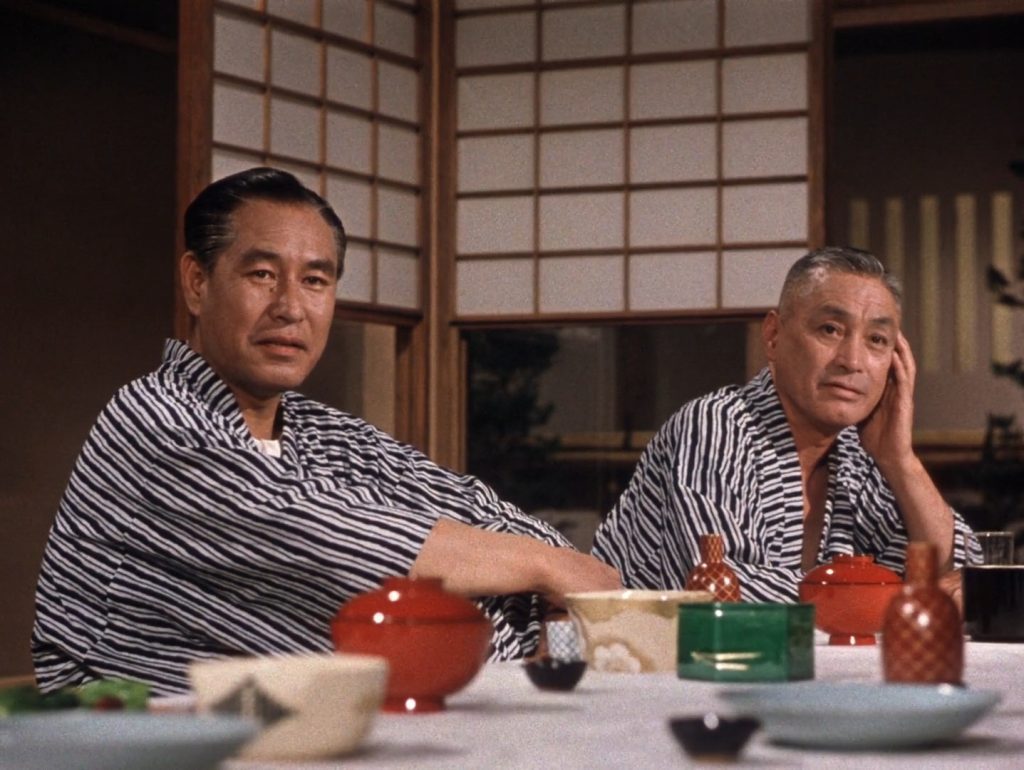Yasujirō Ozu | 1hr 58min

At the wedding which opens Equinox Flower, it appears that respected businessman Wataru Hirayama couldn’t be a more liberal, open-minded father. “My own marriage was a much more pragmatic and routine one,” he reflects, considering the narrow path of tradition that his parents laid out for him. “In that respect, the newlyweds are truly fortunate to have this opportunity, and I can’t help but envy them.” Even among his more conservative friends, he is treated as a source of modern wisdom, lending compassion to their children who resist arranged marriages and pursue their own romantic interests.
When a young man comes knocking at Hirayama’s office door asking for consent to marry his daughter though, those high-minded principles suddenly come into question. Who is this stranger, appearing out of nowhere to insist on Setsuko’s hand? Masahiko, apparently – her colleague who has dating her for quite some time. He is not from a distinguished family, but she is adamant that they will be together even if it means defying her father’s wishes, and pursuing the happiness she knows they will have together. Hirayama’s accusations of insolence are negligible, and his hypocrisy outstanding. It is one thing to accept society’s shift towards more progressive ideals, and another to allow it into your own untouchable life.



Yasujirō Ozu’s foray into colour cinematography aligns beautifully with Equinox Flower’s eloquent optimism, demonstrating an immediate affinity for the emotional cues in a row of green office chairs, or the burst of vibrance in his trademark laundry cutaway. His lighting too illuminates bold, primary palettes through alleyways, dotting the darkness with commercial signs in blue, red, and yellow hues, though it is the warmer ender of the spectrum which most distinctly radiates through his meticulous mise-en-scène. Hirayama’s crimson kettle is especially prominent, inevitably appearing in almost every wide shot of his home, and carrying the colour through other assorted pieces of décor and costuming. Later, it is accompanied by a serving of orange soda upon the table, while at a golf course this same, vivid red is blended with yellow stripes adorning its flags and awning.



Even as Ozu pushes his expressive visuals beyond the realm of black-and-white though, Equinox Flower is unmistakably the work of a director with unlimited concentration and persistence, observing the discontent of familiar environments through a patient, static lens. Conflict spills out from the walls of family homes here and into offices and bars, with the latter setting an especially handsome scene for Hirayama’s meeting with Fumiko, his friend Mikami’s stubbornly independent daughter. There, shades of red continue to be drawn through lampshades, wall posters, and the telephone, as he listens to her explain why she ran away from home and moved in with her boyfriend. To the older generation, disobeying one’s parents so directly is an unthinkable social transgression, yet Hirayama’s empathy is void of judgement. With the respected businessman’s subordinate accompanying him on this journey, Ozu even inserts flashes of humour, as we watch him awkwardly try to appease his boss without stepping out of line.



For Setsuko’s friend Yukiko as well, Hirayama is a source of comfort, offering reprieve from the pressures in her family. Recognising his hypocrisy when it comes to his own though, Yukiko steps in on behalf of Setsuko and concocts a ruse. She herself is in love with someone else, she lies to Hirayama, and yet her mother is insistent on an arranged marriage to someone else. His response is kind, if not particularly thought through – so long as he is a good man and she can be responsible, then “do as you wish,” he advises. “You don’t have to listen to her.”
The trap is immediately sprung, and Hirayama barely has time to respond before Yukiko runs off to inform Setsuko that he approves of her marriage. Not even his foul mood can stop the ball from rolling now – Setsuko has already booked a train to leave with Masahiko tomorrow morning, his wife Kiyoko has come around on the matter, and it seems that everyone else but him is planning to attend. His acceptance is not marked by a grand change of heart, but rather the resigned acquisition of formal gloves and socks, signalling a reluctant surrender. “How can I not go? Our friends are going,” he grumbles, finally conceding defeat to his tearful, deeply grateful daughter.


True to Ozu’s elliptical storytelling, Equinox Flower dwells more on life as it unfolds between defining events than the milestones themselves. In place of Setsuko’s wedding, we instead attend a small reception between Hirayama’s friends after the ceremony, where he learns from Mikami that he too has accepted his daughter’s choices. Red, green, and blue crockery decorates the table where they gather, and lines the bottom of the frame in mid-shots as Mikami sings a farewell poem based on the works of a fourteenth-century samurai.
“The precepts of my father
Remain deep in memory
The edict of the emperor
I’ll follow faithfully
Ten years of patience
Now the great day is here
Strike a mighty blow
Fill the foe with fear
For the emperor’s cause
We fight once again
Vowing that we will battle
And die as men.”

The full, four-minute elegy runs beyond the excerpt here, shifting from the epic to the lyrical as the noble warrior it memorialises takes a moment to ponder “what is the world coming to?”. The tension between one’s duty and humanity lies at the core of his internal conflict, and in Equinox Flower, echoes across centuries into modern Japan as well. With Hirayama’s decision to make a fresh start and visit Setsuko in Hiroshima, Ozu finds grace in the promise of reconciliation, though not without acknowledging the emotional cost of acceptance. Embracing change in one’s life requires far greater humility than welcoming it into society after all, and as Hirayama softly hums to himself on a train towards healing, Equinox Flower recognises that even the most rigid traditions can bend towards love.


Equinox Flower is currently streaming on The Criterion Channel.

